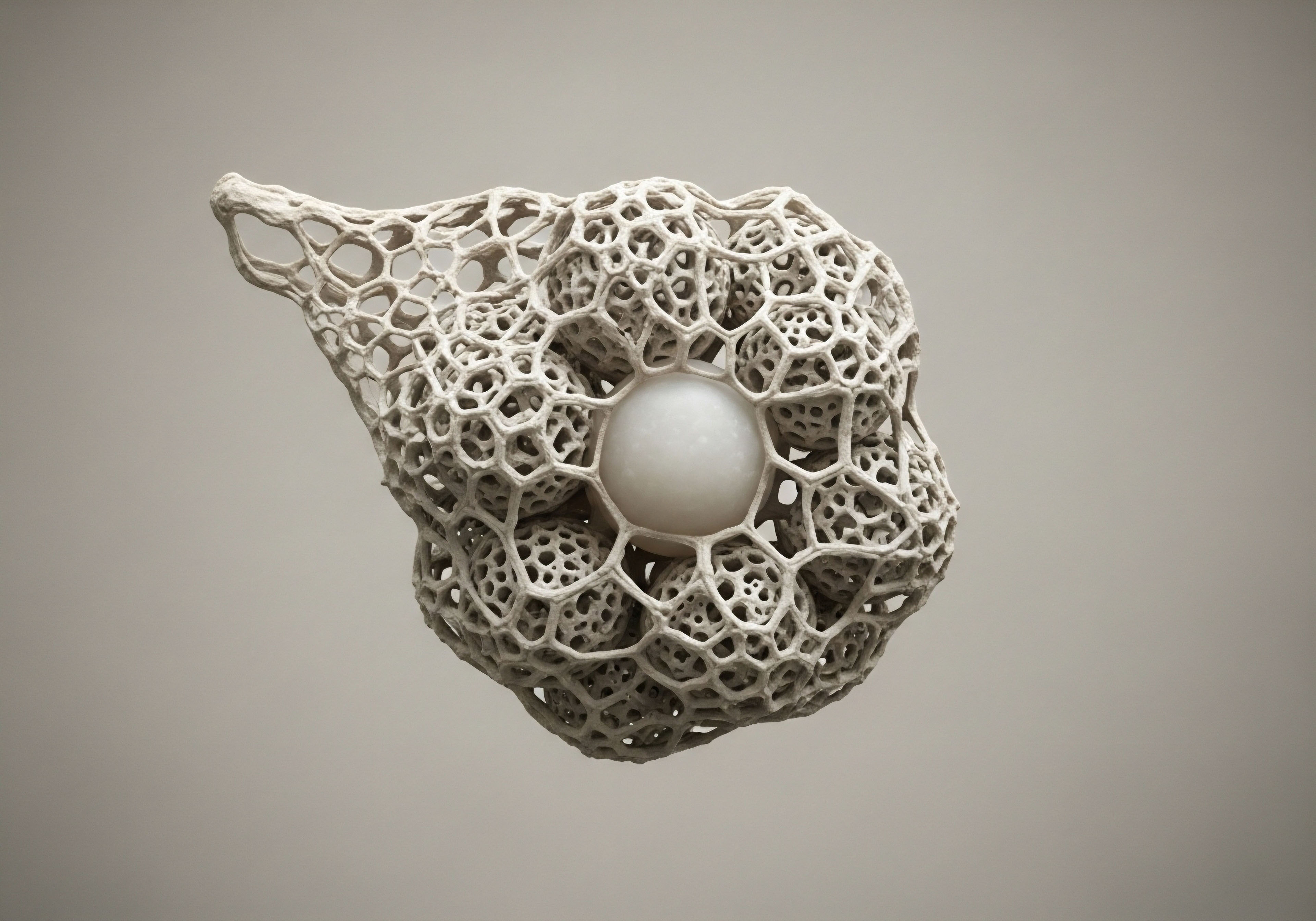

Fundamentals
The persistent fatigue, the unexpected weight changes, the irregular cycles, and the frustrating skin concerns ∞ these are not simply isolated occurrences. They are often signals from your body, communicating an underlying imbalance within its intricate messaging system. For many, these experiences point towards conditions like Polycystic Ovary Syndrome (PCOS), a complex endocrine and metabolic disorder that extends far beyond reproductive health.
It touches every aspect of well-being, influencing energy levels, mood stability, and even long-term health trajectories. Understanding these signals marks the initial step in reclaiming vitality and function without compromise.
PCOS represents a significant challenge for individuals, characterized by a constellation of symptoms arising from hormonal dysregulation. The primary features frequently include hyperandrogenism, which refers to elevated levels of male hormones, leading to symptoms such as hirsutism, acne, and androgenic alopecia. Another common characteristic involves ovulatory dysfunction, manifesting as irregular or absent menstrual periods.
Additionally, the presence of polycystic ovaries, identified via ultrasound, often accompanies these clinical signs. These elements collectively contribute to the lived experience of PCOS, creating a unique set of concerns for each individual.
The endocrine system operates as a sophisticated network of glands and organs that produce and release hormones, serving as chemical messengers throughout the body. These messengers regulate nearly every physiological process, from metabolism and growth to mood and reproduction. In PCOS, this delicate balance is disrupted, particularly concerning the interplay of insulin, androgens, and gonadotropins.
The hypothalamus, pituitary gland, and ovaries form a critical communication axis, known as the Hypothalamic-Pituitary-Gonadal (HPG) axis, which orchestrates reproductive function. Disturbances within this axis contribute significantly to the ovulatory irregularities observed in PCOS.
PCOS symptoms are the body’s communication of an underlying endocrine and metabolic imbalance, extending beyond reproductive health to impact overall vitality.
A central component of PCOS pathophysiology involves insulin resistance, a condition where the body’s cells do not respond effectively to insulin. Insulin, a hormone produced by the pancreas, facilitates glucose uptake from the bloodstream into cells for energy.
When cells become resistant, the pancreas compensates by producing more insulin, leading to elevated insulin levels in the blood, a state known as hyperinsulinemia. This excess insulin then stimulates the ovaries to produce more androgens, exacerbating the hormonal imbalance characteristic of PCOS. This metabolic dysfunction often precedes or coexists with the reproductive symptoms, highlighting the interconnectedness of these biological systems.

Understanding Hormonal Communication
Hormones function much like a finely tuned internal messaging service, transmitting instructions between different parts of the body. Each hormone has specific target cells with corresponding receptors, ensuring that messages are delivered precisely where needed. For instance, luteinizing hormone (LH) and follicle-stimulating hormone (FSH), produced by the pituitary gland, regulate ovarian function.
In PCOS, the pulsatile release of LH can be altered, leading to an unfavorable LH:FSH ratio that impairs follicular development and ovulation. This disruption in the signaling cascade contributes to the anovulation or oligo-ovulation commonly observed.
The adrenal glands also contribute to the hormonal landscape, producing various hormones, including androgens. In some individuals with PCOS, adrenal androgen excess may play a role, further contributing to hyperandrogenism. The liver, too, plays a vital part in hormone metabolism, clearing hormones from the bloodstream and producing binding proteins that transport hormones.
Alterations in liver function or the production of these binding proteins, such as sex hormone-binding globulin (SHBG), can influence the bioavailability of hormones, meaning the amount of active hormone circulating in the body. A lower SHBG level, often seen in PCOS, means more free, active androgens are available, intensifying their effects.

The Body’s Internal Thermostat
Consider the body’s hormonal system as a sophisticated thermostat. When hormone levels deviate from their optimal range, feedback loops signal the glands to adjust production, aiming to restore equilibrium. In PCOS, this feedback mechanism becomes dysregulated. For example, the elevated androgen levels can interfere with the brain’s signals to the pituitary, perpetuating the cycle of hormonal imbalance.
Addressing these underlying dysregulations, rather than merely managing symptoms, becomes paramount for restoring systemic balance. This comprehensive view allows for a more effective and personalized approach to wellness.


Intermediate
Navigating the complexities of PCOS requires a strategic approach that extends beyond conventional symptom management. Lifestyle interventions stand as a powerful initial line of defense, offering a pathway to recalibrate the body’s internal systems without immediate reliance on pharmacological agents. These interventions are not merely supplementary; they represent foundational strategies aimed at addressing the root causes of hormonal and metabolic dysregulation inherent in PCOS. The goal is to restore physiological balance, thereby mitigating symptoms and enhancing overall well-being.
The efficacy of lifestyle modifications in PCOS is well-documented, particularly concerning improvements in insulin sensitivity, androgen levels, and ovulatory function. A personalized protocol typically integrates dietary adjustments, targeted physical activity, stress modulation techniques, and optimized sleep hygiene. Each component plays a distinct yet interconnected role in supporting endocrine health.

Dietary Recalibration for Metabolic Health
Dietary interventions represent a cornerstone of PCOS management. The primary objective involves improving insulin sensitivity and reducing hyperinsulinemia, which directly influences androgen production. A dietary pattern that emphasizes whole, unprocessed foods, with a controlled intake of refined carbohydrates and sugars, can significantly impact metabolic markers.
- Glycemic Load Management ∞ Prioritizing foods with a low glycemic index helps stabilize blood sugar levels, reducing the demand for insulin. This includes non-starchy vegetables, lean proteins, and healthy fats.
- Anti-Inflammatory Foods ∞ Incorporating foods rich in antioxidants and anti-inflammatory compounds, such as berries, leafy greens, and omega-3 fatty acids, can mitigate systemic inflammation often associated with insulin resistance in PCOS.
- Fiber Intake ∞ Adequate fiber supports gut health and aids in glucose regulation, contributing to improved insulin sensitivity.
Consider the impact of a balanced meal on your body’s glucose response. When you consume a meal rich in protein, healthy fats, and fiber, the absorption of glucose into the bloodstream is slowed. This gradual release prevents sharp spikes in blood sugar and subsequent surges in insulin, thereby reducing the stimulus for ovarian androgen production.
This approach contrasts sharply with meals high in refined carbohydrates, which can trigger rapid glucose absorption and a pronounced insulin response, perpetuating the metabolic dysregulation seen in PCOS.
Dietary adjustments, focusing on low glycemic load and anti-inflammatory foods, are crucial for improving insulin sensitivity and reducing androgen levels in PCOS.

Targeted Physical Activity and Body Composition
Regular physical activity serves as a potent tool for enhancing insulin sensitivity and improving body composition, both critical for PCOS management. Exercise increases glucose uptake by muscle cells independently of insulin, thereby reducing the overall insulin burden on the body.
A balanced exercise regimen typically combines both aerobic and resistance training. Aerobic activities, such as brisk walking, cycling, or swimming, improve cardiovascular health and contribute to caloric expenditure. Resistance training, including weightlifting or bodyweight exercises, builds muscle mass. Increased muscle mass improves metabolic flexibility, as muscle tissue is a primary site for glucose utilization. This dual approach maximizes the metabolic benefits, supporting sustained hormonal balance.

Stress Modulation and Cortisol Regulation
Chronic stress can significantly impact hormonal balance, particularly through the hypothalamic-pituitary-adrenal (HPA) axis. Elevated and prolonged cortisol levels, a stress hormone, can exacerbate insulin resistance and influence androgen production. Implementing effective stress modulation techniques is therefore integral to a comprehensive lifestyle protocol.
Techniques such as mindfulness meditation, deep breathing exercises, yoga, and spending time in nature can help regulate the HPA axis, reducing cortisol secretion. Prioritizing adequate sleep, typically 7-9 hours per night, also plays a vital role in stress recovery and hormonal regulation. Poor sleep quality can impair glucose metabolism and increase insulin resistance, creating a vicious cycle for individuals with PCOS.
While the primary focus remains on lifestyle interventions, understanding the broader landscape of hormonal optimization protocols can provide context. For instance, in other endocrine imbalances, specific peptides are utilized to support physiological function. Growth Hormone Peptide Therapy, involving agents like Sermorelin or Ipamorelin / CJC-1295, aims to stimulate the body’s natural production of growth hormone.
This can support muscle gain, fat loss, and sleep improvement in targeted populations, demonstrating how precise biochemical recalibration can address systemic needs. Similarly, Testosterone Replacement Therapy (TRT), while not a primary PCOS treatment, illustrates the principle of restoring hormonal equilibrium.
In men, TRT protocols often involve weekly intramuscular injections of Testosterone Cypionate, sometimes combined with Gonadorelin to maintain natural production and fertility, and Anastrozole to manage estrogen conversion. For women, lower doses of Testosterone Cypionate via subcutaneous injection or pellet therapy are used to address symptoms like low libido or mood changes, often alongside Progesterone. These examples underscore the precision available in endocrine system support, even as we prioritize lifestyle for PCOS.
The following table outlines key lifestyle interventions and their physiological impact on PCOS:
| Lifestyle Intervention | Primary Physiological Impact | Benefit for PCOS |
|---|---|---|
| Dietary Adjustments (Low Glycemic Load) | Improved insulin sensitivity, reduced hyperinsulinemia | Decreased androgen production, improved ovulatory function |
| Regular Physical Activity (Aerobic & Resistance) | Enhanced glucose uptake, increased muscle mass | Reduced insulin resistance, improved body composition |
| Stress Modulation (Mindfulness, Sleep) | HPA axis regulation, reduced cortisol | Improved insulin sensitivity, better mood regulation |
| Optimized Sleep Hygiene | Hormonal rhythm restoration, reduced inflammation | Better glucose metabolism, enhanced recovery |
Can lifestyle interventions truly sustain hormonal balance without pharmacological support in PCOS? The evidence strongly suggests that for many individuals, comprehensive and consistent lifestyle changes can indeed lead to significant improvements in hormonal and metabolic markers, often reducing the need for or complementing pharmacological interventions. This approach empowers individuals to take an active role in their health journey, leveraging the body’s innate capacity for self-regulation.


Academic
The question of whether lifestyle interventions alone can sustain hormonal balance in Polycystic Ovary Syndrome (PCOS) warrants a deep exploration into the underlying systems biology. PCOS is not a singular disorder but a complex syndrome characterized by a confluence of endocrine, metabolic, and inflammatory dysregulations.
While pharmacological agents target specific pathways, lifestyle interventions offer a systems-level recalibration, addressing the interconnectedness of these biological axes. This section analyzes the mechanisms through which such interventions exert their influence, drawing upon clinical research and physiological principles.
The central metabolic disturbance in PCOS involves insulin resistance, affecting approximately 70-80% of individuals with the syndrome, irrespective of body weight. This resistance leads to compensatory hyperinsulinemia, which directly stimulates ovarian and adrenal androgen production. Insulin also suppresses hepatic production of sex hormone-binding globulin (SHBG), a protein that binds to androgens, making them biologically inactive. A reduction in SHBG results in higher levels of free, biologically active androgens, exacerbating clinical hyperandrogenism.

Adipose Tissue Dysfunction and Inflammation
Beyond direct insulin resistance, adipose tissue dysfunction plays a significant role in PCOS pathophysiology. Visceral adiposity, even in individuals with a normal body mass index, is often associated with increased inflammatory cytokine production, such as tumor necrosis factor-alpha (TNF-α) and interleukin-6 (IL-6).
These pro-inflammatory mediators can further impair insulin signaling pathways in peripheral tissues, creating a self-perpetuating cycle of insulin resistance and inflammation. Lifestyle interventions, particularly dietary modifications and regular physical activity, can mitigate this adipose tissue inflammation. For instance, a reduction in saturated fat intake and an increase in omega-3 fatty acids can modulate inflammatory pathways, improving cellular insulin sensitivity.
The impact of physical activity extends to molecular mechanisms. Exercise stimulates the translocation of glucose transporter type 4 (GLUT4) to the cell membrane in muscle tissue, enhancing glucose uptake independently of insulin. This acute effect contributes to immediate improvements in glucose disposal, while chronic exercise training leads to adaptations in mitochondrial function and increased oxidative capacity, further improving metabolic flexibility.
Resistance training, specifically, increases muscle mass, which serves as a larger reservoir for glucose utilization, thereby reducing the overall glucose burden on the pancreatic beta cells.

Neuroendocrine Dysregulation and the HPG Axis
The neuroendocrine component of PCOS involves dysregulation of the Hypothalamic-Pituitary-Gonadal (HPG) axis. Individuals with PCOS often exhibit an increased pulsatility of gonadotropin-releasing hormone (GnRH) from the hypothalamus, leading to a preferential secretion of luteinizing hormone (LH) over follicle-stimulating hormone (FSH) from the pituitary gland. This elevated LH:FSH ratio contributes to impaired follicular development and anovulation. Hyperinsulinemia can directly enhance GnRH pulsatility and ovarian androgen production, creating a direct link between metabolic and reproductive dysfunction.
Stress modulation techniques, such as mindfulness and adequate sleep, influence the Hypothalamic-Pituitary-Adrenal (HPA) axis. Chronic activation of the HPA axis leads to sustained cortisol elevation. Cortisol can induce insulin resistance by increasing hepatic glucose production and decreasing peripheral glucose uptake. Therefore, interventions that reduce chronic stress and improve sleep quality can indirectly support HPG axis regulation by normalizing cortisol levels and improving insulin sensitivity. This multi-axis interplay underscores the systems-biology approach to PCOS management.
Consider the intricate feedback loops governing hormonal equilibrium. When lifestyle interventions successfully reduce insulin resistance, the subsequent decrease in hyperinsulinemia lessens the direct ovarian stimulation for androgen production. This reduction in androgens can then improve the sensitivity of the hypothalamus and pituitary to ovarian signals, potentially normalizing GnRH pulsatility and restoring a more favorable LH:FSH ratio. This cascade of events can lead to improved follicular maturation and spontaneous ovulation, demonstrating a self-correcting mechanism initiated by lifestyle changes.
Lifestyle interventions offer a systems-level recalibration for PCOS, addressing the interconnected endocrine, metabolic, and inflammatory dysregulations.

Pharmacological Parallels and Lifestyle Efficacy
While the focus here is on lifestyle, understanding the mechanisms of pharmacological agents used in broader hormonal health contexts can illuminate the power of endogenous regulation. For instance, in male hormone optimization, Testosterone Replacement Therapy (TRT) often involves weekly intramuscular injections of Testosterone Cypionate.
To mitigate side effects like estrogen conversion, an aromatase inhibitor such as Anastrozole is frequently co-administered. To preserve endogenous testosterone production and fertility, Gonadorelin, a GnRH analog, may be given subcutaneously twice weekly. These agents precisely modulate specific pathways to restore hormonal balance.
Similarly, in female hormone balance, low-dose Testosterone Cypionate (typically 0.1-0.2ml weekly subcutaneously) can address symptoms like low libido, while Progesterone is prescribed based on menopausal status to support uterine health and hormonal rhythm. These interventions highlight the targeted nature of biochemical recalibration.
For individuals seeking anti-aging or performance benefits, Growth Hormone Peptide Therapy utilizes agents like Sermorelin or Ipamorelin / CJC-1295, which stimulate the pituitary’s natural growth hormone release. These peptides act on specific receptors to enhance muscle protein synthesis, lipolysis, and tissue repair. The precision of these pharmacological interventions underscores the body’s capacity for specific responses when appropriate signals are provided.
The effectiveness of lifestyle interventions in PCOS can be compared to the precision of these pharmacological approaches, albeit through endogenous mechanisms. By optimizing diet, exercise, and stress management, the body is provided with the optimal environment to self-regulate its hormonal systems. This leads to a reduction in insulin resistance, a decrease in androgen levels, and an improvement in ovulatory function, often to a degree comparable to or exceeding that achieved with single-agent pharmacological therapies for specific PCOS symptoms.
Can lifestyle interventions fully address the metabolic and hormonal dysregulation in PCOS? For many, they provide a robust and sustainable foundation, often reducing the need for or optimizing the effectiveness of pharmacological support. The long-term adherence to these changes is critical for sustained benefits.
Lifestyle changes in PCOS can normalize insulin sensitivity and androgen levels, often leading to improved ovulatory function through endogenous self-regulation.
The following table summarizes key metabolic and endocrine markers influenced by lifestyle interventions in PCOS:
| Marker | Typical State in PCOS | Impact of Lifestyle Intervention | Mechanism of Change |
|---|---|---|---|
| Insulin Sensitivity | Reduced | Improved | Decreased visceral fat, increased GLUT4 translocation, reduced inflammation |
| Androgen Levels (Total & Free Testosterone) | Elevated | Reduced | Decreased ovarian stimulation from insulin, increased SHBG production |
| LH:FSH Ratio | Elevated | Normalized | Improved hypothalamic sensitivity, reduced GnRH pulsatility |
| SHBG (Sex Hormone-Binding Globulin) | Reduced | Increased | Reduced hyperinsulinemia, improved hepatic function |
| Inflammatory Markers (e.g. CRP) | Elevated | Reduced | Anti-inflammatory diet, reduced adiposity, stress modulation |
The comprehensive nature of lifestyle interventions allows for a simultaneous address of multiple contributing factors in PCOS, offering a holistic pathway towards hormonal equilibrium. This approach respects the body’s inherent capacity for healing and adaptation when provided with the appropriate physiological signals.

References
- Dunaif, Andrea. “Insulin resistance and the polycystic ovary syndrome ∞ mechanism and implications for pathogenesis.” Endocrine Reviews, vol. 18, no. 6, 1997, pp. 774-800.
- Diamanti-Kandarakis, Evanthia, and Andrea Dunaif. “Insulin resistance and the polycystic ovary syndrome revisited ∞ an update on mechanisms and implications.” Endocrine Reviews, vol. 33, no. 6, 2012, pp. 981-1030.
- Spritzer, Poli Mara, et al. “Adipose tissue and metabolic dysfunction in polycystic ovary syndrome.” Human Reproduction Update, vol. 20, no. 6, 2014, pp. 861-878.
- Ivy, John L. “Role of exercise training in the prevention and treatment of insulin resistance and non-insulin-dependent diabetes mellitus.” Sports Medicine, vol. 24, no. 5, 1997, pp. 321-336.
- Marshall, John C. and Robert L. Dalkin. “The GnRH pulse generator ∞ a key to understanding the neuroendocrine control of reproduction.” Journal of Clinical Endocrinology & Metabolism, vol. 79, no. 5, 1994, pp. 1215-1219.
- Bjorntorp, Per. “Body fat distribution, insulin resistance, and metabolic diseases.” Nutrition, vol. 13, no. 9, 1997, pp. 795-803.
- Legro, Richard S. et al. “Effects of Metformin and Lifestyle Changes on Ovulatory Function in Women With Polycystic Ovary Syndrome ∞ A Randomized Controlled Trial.” JAMA, vol. 294, no. 20, 2005, pp. 2692-2700.
- Moran, Lisa J. et al. “The role of diet in the management of polycystic ovary syndrome.” Human Reproduction Update, vol. 16, no. 5, 2010, pp. 459-473.
- Pasquali, Renato, et al. “Lifestyle modifications in women with polycystic ovary syndrome.” Journal of Clinical Endocrinology & Metabolism, vol. 96, no. 11, 2011, pp. 3283-3288.

Reflection
Your journey towards understanding your body’s unique biological systems is a deeply personal one, a path of discovery that begins with acknowledging your symptoms and seeking clarity. The knowledge shared here about PCOS and the profound impact of lifestyle interventions serves as a foundational guide, illuminating the intricate connections within your endocrine and metabolic landscape.
This information is not merely a collection of facts; it is a framework for introspection, inviting you to consider how these principles apply to your own lived experience.
Recognizing the body’s capacity for self-regulation, particularly when supported by precise and consistent lifestyle adjustments, shifts the perspective from passive symptom management to active physiological recalibration. Each dietary choice, every movement, and the quality of your rest contribute to a cumulative effect on your hormonal symphony. This understanding empowers you to become an active participant in your wellness, rather than a bystander.

Your Path to Vitality
The insights presented underscore that while the science provides the map, your individual biology dictates the terrain. True vitality and sustained function arise from a personalized approach, one that integrates evidence-based strategies with your unique physiological responses. This requires ongoing observation, adjustment, and a commitment to understanding the subtle cues your body provides.

Continuing the Conversation
Consider this exploration a starting point, a catalyst for deeper inquiry into your own health narrative. The principles of hormonal balance and metabolic health are universal, yet their application is always individual. Moving forward, the goal is to refine your understanding, allowing you to make informed choices that support your long-term well-being and enable you to reclaim your full potential.



